Module 6 - Introduction to Electronic Emission, Tubes, and Power
Supplies
Pages i,
1-1,
1-11,
1-21,
1-31,
1-41,
1-51,
2-1,
2-11,
2-21,
2-31,
3-1,
3-11,
3-21,
3-31,
3-41,
3-51, AI-1, Index
Resistor-Capacitor
(RC) Filters The RC capacitor-input filter is limited to applications in which the load current
is small. This type of filter is used in power supplies where the load current is constant and voltage regulation
is not necessary. For example, RC filters are used in high-voltage power supplies for cathode-ray tubes and as
part of decoupling networks for multistage amplifiers. Figure 3-37 shows an RC capacitor-input filter and
its associated waveforms. Both half-wave and full-wave rectifiers are used to provide the inputs.
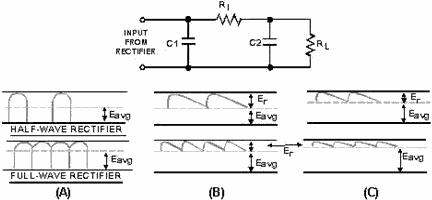
Figure 3-37. - RC filter and waveforms. The RC filter in figure 3-37 consists of an input filter capacitor (C1), a series resistor (R1), and an
output filter capacitor (C2). Although not part of the RC filter, RL is shown to help explain the
circuit. This filter is sometimes referred to as an RC pi-section filter because its schematic symbol resembles
the Greek letter !. Although the single capacitor filter is suitable for many noncritical, low-current
applications, when the load resistance is very low or when the percent of ripple must be held to an absolute
minimum, the capacitor must have an extremely large value. While electrolytic capacitors are available in sizes up
to 10,000 µF or greater, the larger sizes are quite expensive. a more practical approach is to use a more
sophisticated filter that can do the same job but that has lower capacitor values, such as the RC filter.
The waveforms shown in the figure represent the unfiltered output from a typical rectifier circuit. Note that the
dashed line, which indicates the average value of output voltage (Eavg) for the half-wave rectifier, is
less than half the amplitude of the voltage peaks (approximately 0.318). The average value of output voltage (Eavg)
for the full-wave rectifier is greater than half (approximately 0.637), but is still much less than, the peak
amplitude of the rectifier-output waveform. With no filter circuit connected across the output of the rectifier
circuit (unfiltered), the waveform has a large value of pulsating component (ripple) as compared to the average
(or dc) component.
3-31
An RC filter, such as a pi-section filter, does a much better job than a single capacitor filter.
Figure 3-37 illustrates an RC filter connected across the output of a rectifier. C1 performs the same function
that it did in the single capacitor filter. It is used to reduce the percentage of ripple to a relatively low
value. Thus, the voltage across C1 might consist of an average dc value of +100 volts with a ripple voltage of 10
volts. This voltage is passed on to the R1-C2 network, which reduces the ripple even further (view C). C2
offers an infinite impedance (resistance) to the dc component of the output voltage. Thus, the dc voltage is
passed to the load, but reduced in value by the amount of the voltage drop across R1. However, R1 is generally
small compared to the load resistance. Therefore, the drop in the dc voltage by R1 is not a drawback.
Component values are designed so that the resistance of R1 is much greater than the reactance of C2 at the ripple
frequency. C2 offers a very low impedance to the ac ripple frequency. Thus, the ac ripple senses a voltage divider
consisting of R1 and C2 between the output of the rectifier and ground. Therefore, most of the ripple voltage is
dropped across R1. Only a trace of the ripple voltage can be seen across C2 and the load. In extreme
cases where the ripple must be held to an absolute minimum, a second stage of RC filtering can be added. In
practice, the second stage is rarely required. The RC filter is extremely popular because smaller capacitors can
be used with good results. The RC filter has some disadvantages, however. First, the voltage drop across
R1 takes voltage away from the load. Second, power is wasted in R1 and is dissipated in the form of unwanted heat.
Finally, if the load resistance changes, the voltage across the load will change. Even so, the advantages of
the RC filter overshadow these disadvantages in many cases. Q27. Is an RC filter used when a large
current or a small current demand is required? Q28. Why is the use of large value capacitors in filter
circuits discouraged?
Q29. When is a second RC filter stage used? The resistor-capacitor (RC) filter is also subject to
problems that can cause it to fail. The shunt capacitors (C1 and C2) are subject to an open circuit, a short
circuit, or excessive leakage. The series filter resistor (R1) is subject to changes in value and occasionally
opens. Any of these troubles can be easily detected. The input capacitor (C1) has the greatest pulsating
voltage applied to it and is the most susceptible to voltage surges. As a result, it is frequently subject to
voltage breakdown and shorting. The remaining shunt capacitor (C2) in the filter circuit is not subject to voltage
surges because of the protection offered by the series filter resistor (R1). However, a shunt capacitor can become
open, leaky, or shorted.
A shorted capacitor or an open filter resistor results in a no-output indication. An open filter resistor
results in an abnormally high dc voltage at the input to the filter and no voltage at the output of the filter.
Leaky capacitors or filter resistors that have lost their effectiveness, or filter resistors that have decreased
in value, result in an excessive ripple amplitude in the output of the supply.
3-32
LC Capacitor-Input Filter The LC input filter is one of the most commonly used filters. This type of filter is used primarily in radio receivers, small audio amplifier power supplies, and
in any type of power supply where the output current is low and the load current is relatively constant.
Figure 3-38 shows an LC capacitor-input filter and its associated waveforms. Both half-wave and full-wave
rectifier circuits are used to provide the inputs.
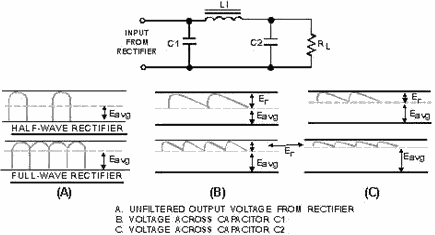
Figure 3-38. - LC capacitor-input filter and waveforms. The waveforms shown in the figure represent the unfiltered output from a typical rectifier circuit. Note
again, that the average value of output voltage (Eavg) for the half-wave rectifier is less than half the amplitude
of the voltage peaks. This is indicated by the dashed line. The average value of output voltage (Eavg)
for the full-wave rectifier is greater than half, but is still much less than the peak amplitude of the
rectifier-output waveform. With no filter circuit connected across the output of the rectifier circuit
(unfiltered), the waveform has a large value of pulsating component (ripple) as compared to the average (or dc)
component. A common type of LC filter is shown in figure 3-38. C1 performs the same functions as
discussed earlier by reducing the ripple to a relatively low level. L1 and C2 form the LC filter, which reduces
the ripple even further (view C).
L1 is a large value iron-core inductor (choke.) It has a high value of inductance and, therefore, a high value of
XL, which offers a high reactance to the ripple frequency. At the same time, C2 offers a very low reactance to the
ac ripple. L1 and C2 form an ac voltage divider and, because the reactance of LI is much higher than that of C2,
most of the ripple voltage is dropped across L1. Only a slight trace of the ripple appears across C2 and the load.
While the L1-C2 network greatly reduces the ac ripple, it has little effect on the dc. You should recall that an
inductor offers no reactance to dc. The only opposition to current flow is the resistance of
3-33
the wire in the choke. Generally, this resistance is very low and the dc voltage drop across the coil
is minimal. Thus, the LC filter overcomes the disadvantages of the RC filter. Aside from the voltage
divider effect, the inductor improves filtering in another way. You should recall that an inductor resists changes
in the magnitude of the current flowing through it. Consequently, when the inductor is placed in series with the
load, the inductor tends to hold the current steady. This, in turn, helps to hold the voltage across the load
constant.
The LC filter provides good filtering action over a wide range of currents. The capacitor filters best
when the load is drawing little current. Thus, the capacitor discharges very slowly and the output voltage remains
almost constant. On the other hand, the inductor filters best when the current is highest. The complementary
nature of these components ensures good filtering over a wide range of current when size of components is a
factor.
The LC filter has two disadvantages. The first is cost. The LC filter is more expensive than the RC filter because
its iron-core choke costs more than the resistor of the RC filter. The second disadvantage is size, since the
iron-core choke is bulky and heavy. Thus, the LC filter may be unsuitable for some applications but is still one
of the most widely used. Q30. What is the most commonly used filter in use today? Q31. What
are the two main disadvantages of an LC capacitor filter? Several problems may cause the LC capacitor
filter to fail. Shunt capacitors are subject to open circuits, short circuits, and excessive leakage; series
inductors are subject to open windings and occasionally shorted turns or a short circuit to the core. The
input capacitor (C1) has the greatest pulsating voltage applied to it, is the most susceptible to voltage surges,
and has a generally higher average voltage applied. As a result, the input capacitor is frequently subject to
voltage breakdown and shorting. The output capacitor (C2) is not as susceptible to voltage surges because of the
series protection offered by the series inductor (L1), but the capacitor can become open, leaky, or shorted.
a shorted capacitor, an open filter choke, or a choke winding that is shorted to the core, results in a no-output
indication. a shorted capacitor, depending on the magnitude of the short, may cause a shorted rectifier,
transformer, or filter choke and result in a blown fuse in the primary of the transformer. An open filter choke
results in an abnormally high dc voltage at the input to the filter and no voltage at the output of the filter. a
leaky or open capacitor in the filter circuit results in a low dc output voltage. This condition is generally
accompanied by an excessive ripple amplitude. Shorted turns in the winding of a filter choke reduce the effective
inductance of the choke and decrease its filtering efficiency. As a result, the ripple amplitude increases.
Voltage REGULATION Ideally, the output of most power supplies should be a constant voltage.
Unfortunately, this is difficult to achieve. There are two factors that can cause the output voltage to change.
First, the ac line voltage is not constant. The so-called 115 volts ac can vary from about 105 volts ac to 125
volts ac. This means that the peak ac voltage to which the rectifier responds can vary from about 148 volts to 177
volts. The ac line voltage alone can be responsible for nearly a 20 percent change in the dc output voltage.
The second factor that can change the dc output voltage is a change in the load resistance. In complex
electronic equipment, the load can change as circuits are switched in and out. In a television
3-34
receiver, the load on a particular power supply may depend on the brightness of the screen, the
control settings, or even the channel selected. These variations in load resistance tend to change the
applied dc voltage because the power supply has a fixed internal resistance. If the load resistance decreases, the
internal resistance of the power supply drops more voltage. This causes a decrease in the voltage across the load.
Many circuits are designed to operate with a particular supply voltage. When the supply voltage changes, the
operation of the circuit may be adversely affected. Consequently, some types of equipment must have power supplies
that produce the same output voltage regardless of changes in the load resistance or changes in the ac line
voltage. This constant supply of power may be achieved by adding a circuit called the Voltage REGULATOR
at the output of the filter. Load REGULATION A commonly used FIGURE of
MERIT
for a power supply is its PERCENT of REGULATION. The figure of merit gives us an indication of
how much the output voltage changes over a range of load resistance values. The percent of regulation aids us in
determining of the type of load regulation needed. Percent of regulation is determined by the equation:

This equation compares the change in output voltage at the two loading extremes to the voltage produced
at full loading. For example, assume that a power supply produces 12 volts when the load current is zero. If the
output voltage drops to 10 volts when full load current flows, then the percent of regulation is:
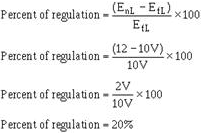
Ideally, the output voltage should not change over the full range of operation. That is, a 12-volt power
supply should produce 12 volts at no load, at full load, and at all points in between. In this case, the percent
of regulation would be:
3-35
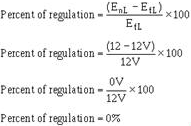
Thus, zero-percent load regulation is the ideal situation. It means that the output voltage is constant
under all load conditions. While you should strive for zero percent load regulation, in practical circuits you
must settle for something less. Even so, by using a voltage regulator, you can hold the percent of regulation to a
very low value. If you are interested in reading more on this subject, refer to the Electronic
Installation and Maintenance Book (EIMB) series or other similar books from your technical library.
Q32. What two factors can cause output dc voltage to change? Q33. What is the commonly used figure of
merit for a power supply? Q34. If a power supply produces 20 volts with no load and 15 volts under full
load, what is the percent of regulation? Q35. What percent of regulation would be ideal?
REGULATORS You know that the output of a power supply varies with changes in input voltage and
circuit load current requirements. Because many military electronic equipments require operating voltages and
currents that must remain constant, some form of regulation is necessary. The circuits that maintain power supply
voltage or current outputs within specified limits, or tolerances, are called regulators. They are designated as
dc voltage or dc current regulators, depending on their specific application. Voltage regulator circuits
are additions to basic power supply circuits and are made up of rectifier and filter sections. The purpose of the
voltage regulator is to provide an output voltage with little or no variation. Regulator circuits sense changes in
output voltages and compensate for the changes. Regulators that maintain voltages within plus or minus (±) 0.1
percent are quite common. The diagram in figure 3-39 clearly illustrates the purpose of the voltage regulator.

Figure 3-39. - Block diagram of a power supply and regulators 3-36
There are two basic types of voltage regulators, series and shunt. Whether a voltage regulator is
classified as series or shunt depends on the location or position of the regulating element(s) in relation to the
circuit load resistance. Figure 3-40 illustrates the two basic types of voltage regulators. In actual
practice the circuitry of regulating devices may be quite complex. We use the simplified drawings in the figure to
emphasize that there are two basic types of voltage regulators. Broken lines highlight the differences between the
series and shunt regulators.
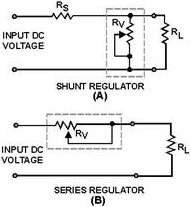
Figure 3-40. - Series and shunt regulators. The schematic in view (A) is that of a shunt-type regulator. It is called a shunt-type regulator because
the regulating device is connected in parallel with the load resistance. This is a characteristic of all shunt-
type regulators. The schematic in view (B) is that of a series regulator. It is called a series regulator because
the regulating device is connected in series with the load resistance. Series Voltage Regulator
Figure 3-41 illustrates the principle of series voltage regulation. As you study the figure, notice that the
regulator is in series with the load resistance and that all current passes through the regulator. In this
example, variable resistor Rv is used for regulation. Examine the circuit to determine how the
regulator functions. When the input voltage increases, the output voltage also increases. However, since the
voltage regulator device (Rv) senses this change, the resistance of the regulating device increases and
results in a greater voltage drop through Rv. This causes the output voltage to decrease to normal or, for all
practical purposes, to remain constant.
3-37

Figure 3-41. - Series voltage regulator. You should be able to see that as the input voltage decreases, the resistance of the variable resistor Rv
decreases almost simultaneously, thereby compensating for the voltage drop. Since there is a smaller voltage drop
across Rv, the output voltage remains almost constant. Voltage fluctuations within the circuit occur in
microseconds. Shunt Voltage Regulator The diagram in figure 3-42 represents a
shunter voltage regulator. Notice that variable resistor Rv is in parallel with the load resistance RL
and that fixed resistor RS is in series with the load resistance. You already know the voltage drop
across a fixed resistor remains constant unless there is a variation (increase or decrease) in the current through
it. In a shunt regulator as shown in figure 3-42, output voltage regulation is determined by the current
through the parallel resistances of the regulating device (Rv), the load resistance (RL),
and the series resistor (RS). For now, assume that the circuit in figure 3-42 is operating under normal
conditions, that the input is 120 volts dc, and that the desired regulated output is 100 volts dc. For a 100-volt
output to be maintained, 20 volts must be dropped across the series resistor (RS). If you assume that
the value of RS
is 2 ohms, then you must have 10 amperes of current through Rv and RL. (Remember: E = IR.)
If the values of the resistance of Rv and RL are equal, then 5 amperes of current will flow
through each resistance (Rv and RL).
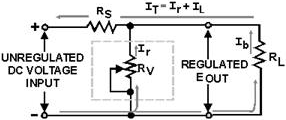
Figure 3-42. - Shunt voltage regulator. Now, if the load resistance (RL) increases, the current through RL will decrease.
For example, assume that the current through RL is now 4 amperes and that the total current through RS
is 9 amperes. With this drop in current, the voltage drop across RS is 18 volts; consequently, the output of the
regulator has increased to 102 volts. At this time, the regulating device (Rv) decreases in resistance,
and 6 amperes of current flows through this resistance (Rv). Thus, the total current through RS is once
again 10 amperes (6 amperes across Rv, 4 amperes through RL); therefore, 20 volts will be
dropped across RS
causing the output to decrease back to 100 volts.
3-38
You should know by now that if the load resistance (RL) increases,
the regulating device (Rv) decreases its resistance to compensate for the
change. If RL decreases, the opposite effect will occur and Rv will increase. Now take a
look at the circuit when a decrease in load resistance takes place. When RL decreases, the
current through RL subsequently increases to 6 amperes. This action causes a total of 11 amperes to flow through RS
which now drops 22 volts. As a result, the output is now 98 volts. However, the regulating device (Rv)
senses this change and increases its resistance so that less current (4 amperes) flows through Rv. The
total current again becomes 10 amperes, and the output is again 100 volts. From these examples, you
should now understand that the shunt regulator maintains the desired output voltage by sensing the current change
that occurs in the parallel resistance of the circuit. Again refer to the schematic shown in figure 3-42
and consider how the voltage regulator operates to compensate for changes in input voltages. You know, of course,
that the input voltage may vary and that any variation must be compensated for by the regulating device. Consider
an increase in input voltage. When this happens the resistance of Rv
automatically decreases to maintain the correct voltage division between Rv and RS. You
should see, therefore, that the regulator operates in the opposite way to compensate for a
decrease in input voltage.
So far we have explained the operation of voltage regulators that use variable resistors; however, this
type of regulation has limitations. Obviously, the variable resistor cannot be adjusted rapidly enough to
compensate for frequent fluctuations in voltage. Since input voltages fluctuate frequently and rapidly, the
variable resistor is not a practical method for voltage regulation. a voltage regulator that operates continuously
and automatically to regulate the output voltage without external manipulation is required. Q36. The
purpose of a voltage regulator is to provide an output voltage with little or no _____. Q37. The two
basic types of voltage regulators are _____ and _____. Q38. When a series voltage regulator is used to
control output voltages, any increase in the input voltage results in
an increase/a decrease in the resistance of the regulating device. Q39. a
shunt type voltage regulator is connected in series/parallel with the load
resistance.
Basic VR Tube Regulator Circuit Although we covered the electrical characteristics of the VR tube in
chapter 2 of this module, we now need to cover the capabilities and limitations of the VR tube itself.
Figure 3-43 shows a basic VR tube regulating circuit. The voltage produced by the source is 150 volts. The VR 90
will provide a constant 90 volts across the load resistance (RL) if the tube is operated in the normal
glow discharge region. This means that 60 volts is dropped across RS, which is the series limiting resistance used
to limit the current through the VR tube.
3-39
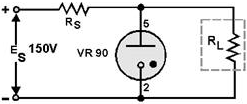
Figure 3-43. - Basic VR tube regulator. Since the operating limits of a VR tube are determined by its maximum and minimum currents, circuits
using such tubes should be designed to allow maximum variations in current above and below the normal point of
operation. The normal point of operation, which allows maximum variation in current, must be midway between the
current limits of the tube. This median current is called Imean. and can be calculated by the use of
the following equation:

We can determine the mean current for the VR90-40 as shown in figure 3-44 by using the following
values:

To calculate the value of series dropping resistance R S, we use the following equation:

If the average current flowing through the load of figure 3-44 is 100 milliamperes, we can find the
series dropping resistance in the following manner:


Figure 3-44. - Simplified VR tube regulator. 3-40
| - |
Matter, Energy,
and Direct Current |
| - |
Alternating Current and Transformers |
| - |
Circuit Protection, Control, and Measurement |
| - |
Electrical Conductors, Wiring Techniques,
and Schematic Reading |
| - |
Generators and Motors |
| - |
Electronic Emission, Tubes, and Power Supplies |
| - |
Solid-State Devices and Power Supplies |
| - |
Amplifiers |
| - |
Wave-Generation and Wave-Shaping Circuits |
| - |
Wave Propagation, Transmission Lines, and
Antennas |
| - |
Microwave Principles |
| - |
Modulation Principles |
| - |
Introduction to Number Systems and Logic Circuits |
| - |
- Introduction to Microelectronics |
| - |
Principles of Synchros, Servos, and Gyros |
| - |
Introduction to Test Equipment |
| - |
Radio-Frequency Communications Principles |
| - |
Radar Principles |
| - |
The Technician's Handbook, Master Glossary |
| - |
Test Methods and Practices |
| - |
Introduction to Digital Computers |
| - |
Magnetic Recording |
| - |
Introduction to Fiber Optics |
| Note: Navy Electricity and Electronics Training
Series (NEETS) content is U.S. Navy property in the public domain. |
|























